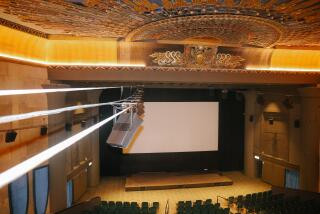Pacific Bell Unveils a New Way of Looking at Movies : Technology: A high-definition digital projection sent over fiber-optic telephone lines would eliminate film.
- Share via
Going to the movies, one has a few basic expectations: There will be popcorn. There will be a good sound system. There will be a projector, projecting a film onto a screen.
Well, there may come a day when one of those assumptions will have to be changed. Movie theaters of the future will likely not show film. Instead, they will show video projections of the original film, sent by fiber optical telephone lines from the studio headquarters in Los Angeles.
Over the weekend and on Monday, Pacific Bell demonstrated its fiber-optic system, called the Advanced Broadcast Video Services, to movie studio officials and the press at the AMC Theater at Burbank’s Media City Center.
Perhaps in honor of the Halloween weekend, Pacific Bell chose to demonstrate the system by showing Francis Ford Coppola’s “Bram Stoker’s Dracula.” From the Sony Pictures High Definition Center in Culver City, “Dracula,” a Columbia release, was converted into digitalized electronic information, then transmitted by fiber-optic telephone lines, decoded at the theater in Burbank and projected onto a 16-by-35-foot screen.
Pacific Bell’s project engineer Richard Mizer called the screening a “conceptual demonstration of things to come,” noting that both Sony and the Hughes Corp. are working on the hardware to do digital projection that, in the future, will have the equivalent quality of 35 mm. film.
The demonstration projection was surprisingly clear and free of grain. Mizer said the format is the same as high-definition TV in Japan: 1,125 lines of resolution.
Those pictures, however, are at their finest when shown on domestic-size TV screens. On a screen as big as one in a movie theater, however, some sharpness is inevitably lost. But the systems to be available in the next few years will utilize 2,000 to 4,000 lines of resolution, which Mizer said would provide better quality.
“It is without a doubt the wave of the future,” said Mark Frysztacki, the head of National Film Service, which distributes virtually all films to theaters throughout the United States, and could be adversely affected by high-definition delivery systems. “But will it happen in the near future? I doubt it.”
Frysztacki, whose firm is based in New Jersey and Los Angeles, said, “the hard part is being able to project the image with the clarity that film has.” His comments reflect a purist view shared by filmmakers that theatrical movie presentations should be a different experience than home viewing.
*
Theaters, he said, predominantly operate with tight profit margins and the cost of investing in new equipment might slow any industry-wide wave of conversion from film to video. AMC’s director of design and development Sam Giordano estimated that cost could be about $100,000 per screen.
On the flip side, some in the distribution side of the business believe the film industry could save as much as $500 million annually on the cost of making prints (each one made of every film can range from $1,300 to $1500) and circulating them from theater to theater.
Another advantage: By eliminating a physical print, there is greater protection against piracy.
More to Read
The biggest entertainment stories
Get our big stories about Hollywood, film, television, music, arts, culture and more right in your inbox as soon as they publish.
You may occasionally receive promotional content from the Los Angeles Times.










